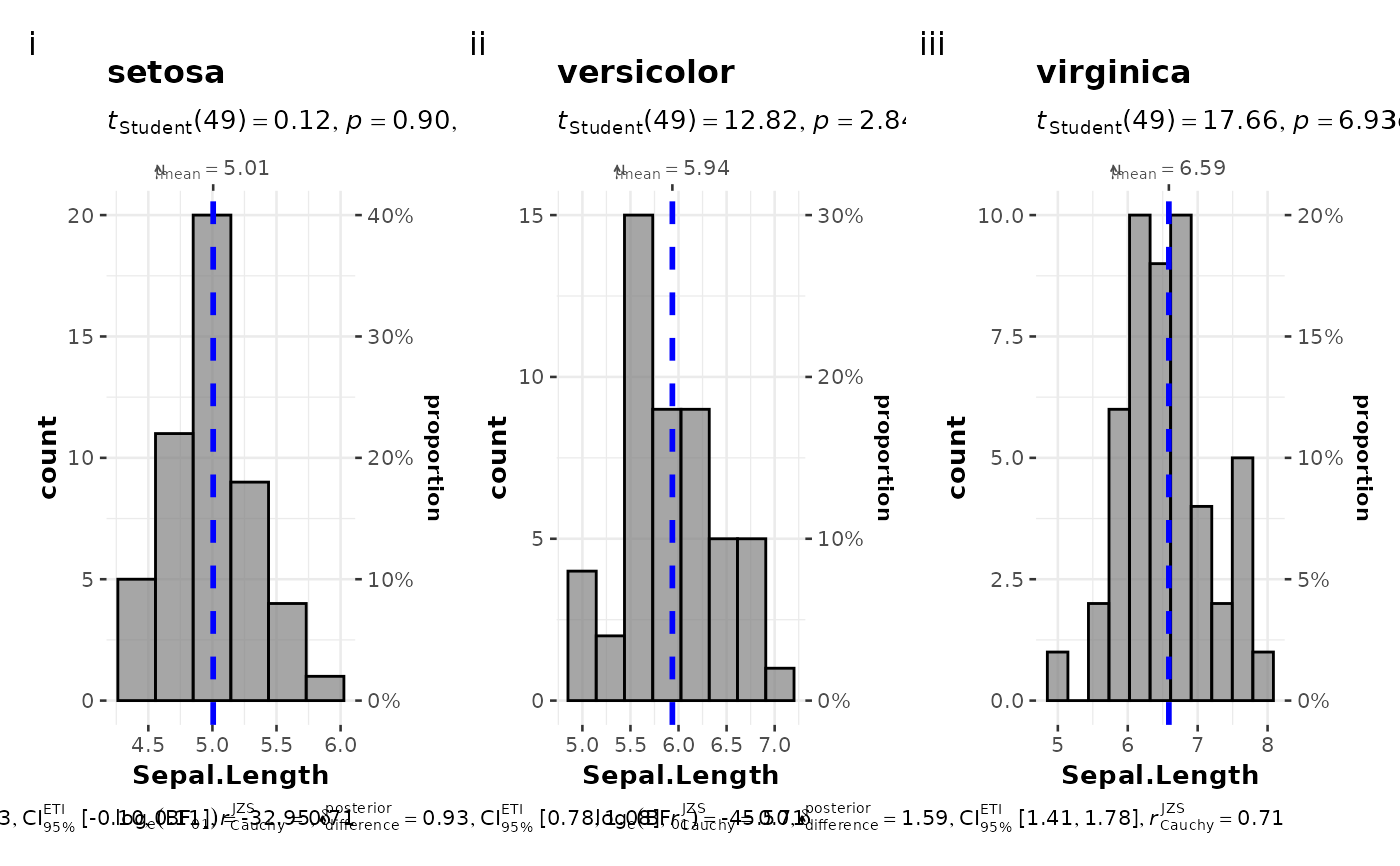
Grouped histograms for distribution of a numeric variable
Source:R/gghistostats.R
grouped_gghistostats.RdHelper function for ggstatsplot::gghistostats to apply this function
across multiple levels of a given factor and combining the resulting plots
using ggstatsplot::combine_plots.
Arguments
- data
A data frame (or a tibble) from which variables specified are to be taken. Other data types (e.g., matrix,table, array, etc.) will not be accepted. Additionally, grouped data frames from
{dplyr}should be ungrouped before they are entered asdata.- x
A numeric variable from the data frame
data.- grouping.var
A single grouping variable.
- binwidth
The width of the histogram bins. Can be specified as a numeric value, or a function that calculates width from
x. The default is to use themax(x) - min(x) / sqrt(N). You should always check this value and explore multiple widths to find the best to illustrate the stories in your data.- plotgrid.args
A
listof additional arguments passed topatchwork::wrap_plots(), except forguidesargument which is already separately specified here.- annotation.args
A
listof additional arguments passed topatchwork::plot_annotation().- ...
Arguments passed on to
gghistostatsbin.argsA list of additional aesthetic arguments to be passed to the
stat_binused to display the bins. Do not specifybinwidthargument in this list since it has already been specified using the dedicated argument.centrality.line.argsA list of additional aesthetic arguments to be passed to the
ggplot2::geom_line()used to display the lines corresponding to the centrality parameter.typeA character specifying the type of statistical approach:
"parametric""nonparametric""robust""bayes"
You can specify just the initial letter.
test.valueA number indicating the true value of the mean (Default:
0).digitsNumber of digits for rounding or significant figures. May also be
"signif"to return significant figures or"scientific"to return scientific notation. Control the number of digits by adding the value as suffix, e.g.digits = "scientific4"to have scientific notation with 4 decimal places, ordigits = "signif5"for 5 significant figures (see alsosignif()).conf.levelScalar between
0and1(default:95%confidence/credible intervals,0.95). IfNULL, no confidence intervals will be computed.trTrim level for the mean when carrying out
robusttests. In case of an error, try reducing the value oftr, which is by default set to0.2. Lowering the value might help.bf.priorA number between
0.5and2(default0.707), the prior width to use in calculating Bayes factors and posterior estimates. In addition to numeric arguments, several named values are also recognized:"medium","wide", and"ultrawide", corresponding to r scale values of1/2,sqrt(2)/2, and1, respectively. In case of an ANOVA, this value corresponds to scale for fixed effects.effsize.typeType of effect size needed for parametric tests. The argument can be
"d"(for Cohen's d) or"g"(for Hedge's g).xlabLabel for
xaxis variable. IfNULL(default), variable name forxwill be used.bf.messageLogical that decides whether to display Bayes Factor in favor of the null hypothesis. This argument is relevant only for parametric test (Default:
TRUE).results.subtitleDecides whether the results of statistical tests are to be displayed as a subtitle (Default:
TRUE). If set toFALSE, only the plot will be returned.subtitleThe text for the plot subtitle. Will work only if
results.subtitle = FALSE.captionThe text for the plot caption. This argument is relevant only if
bf.message = FALSE.centrality.plottingLogical that decides whether centrality tendency measure is to be displayed as a point with a label (Default:
TRUE). Function decides which central tendency measure to show depending on thetypeargument.mean for parametric statistics
median for non-parametric statistics
trimmed mean for robust statistics
MAP estimator for Bayesian statistics
If you want default centrality parameter, you can specify this using
centrality.typeargument.centrality.typeDecides which centrality parameter is to be displayed. The default is to choose the same as
typeargument. You can specify this to be:"parameteric"(for mean)"nonparametric"(for median)robust(for trimmed mean)bayes(for MAP estimator)
Just as
typeargument, abbreviations are also accepted.ggplot.componentA
ggplotcomponent to be added to the plot prepared by{ggstatsplot}. This argument is primarily helpful forgrouped_variants of all primary functions. Default isNULL. The argument should be entered as a{ggplot2}function or a list of{ggplot2}functions.ggthemeA
{ggplot2}theme. Default value istheme_ggstatsplot(). Any of the{ggplot2}themes (e.g.,ggplot2::theme_bw()), or themes from extension packages are allowed (e.g.,ggthemes::theme_fivethirtyeight(),hrbrthemes::theme_ipsum_ps(), etc.). But note that sometimes these themes will remove some of the details that{ggstatsplot}plots typically contains. For example, if relevant,ggbetweenstats()shows details about multiple comparison test as a label on the secondary Y-axis. Some themes (e.g.ggthemes::theme_fivethirtyeight()) will remove the secondary Y-axis and thus the details as well.
Details
For details, see: https://indrajeetpatil.github.io/ggstatsplot/articles/web_only/gghistostats.html
